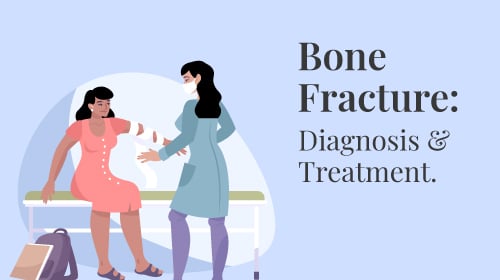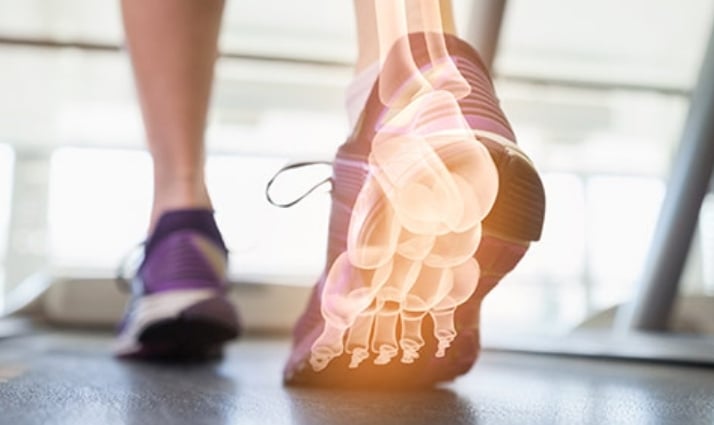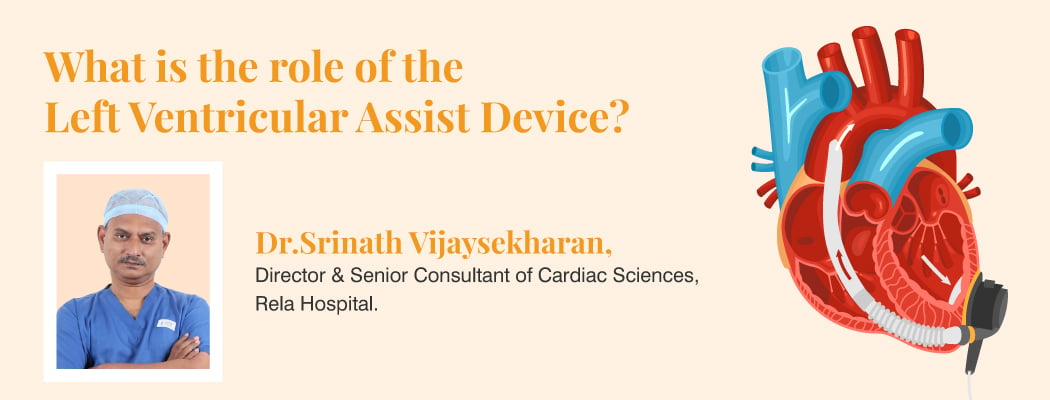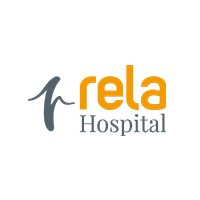Bone Fractures: Types, Symptoms & Treatment
October 17, 2022

Bone fractures are frequent injuries that can occur at any age. If you’re over fifty or have a family background of osteoporosis, discuss quickly with your physician getting a bone density test.
Contents
If you break a bone, surgery may be required to heal it. Some patients need a splint, cast, brace, or sling to mend their bones. The time it takes to recover fully depends on which of your bones is fractured, where the fracture is located, and what caused it.
Bone fracture vs Broken bones
and fractured bones are the same damage and have the same meaning. They may be used interchangeably. Because a fracture is a medical word for a broken bone, your healthcare professional will most likely refer to your fractured bone as a specific type of fracture once it has been diagnosed.
Bone fractures vs Bone bruises
Both bone fractures and bone bruising are painful injuries produced by a powerful force striking your body, typically in the form of a fall, automobile accident, or sports injury. The difference is the extent to which your bone has been affected.
Your bones are living tissue which may bruise in the same manner that your skin does. A bruised bone requires far more power than bruised skin, although the damage is highly similar. If something strikes your bones hard enough, they can bleed without breaking. A bone bruise is caused by blood trapped beneath the surface of your bone following an accident.
A bone fracture occurs when something strikes your bone with enough power to shatter it in at least one spot. Fractures are more dangerous than bone bruising and can take considerably longer to heal.
If you’ve had a trauma and are experiencing pain on or near a bone, go to the emergency department or see your physician as soon as possible. It is critical to have your bone checked as quickly as possible, regardless of the type of damage you have.
Bone fractures vs Sprains
Sprains and bone fractures are widespread sports injuries. If you have a bone fracture, you’ve shattered one or more of your bones. A bone cannot be sprained. A sprain occurs when a ligament is strained or torn. A bone fracture and a ligament sprain can occur in the same incident, especially if you injure a joint like your knee or elbow.
Different types of Bone fractures
There are several forms of fractures. A particular fracture type will be diagnosed by your physician based on a few factors, including
- Pattern: A fracture pattern is a medical word describing the form or appearance of a break.
- Cause: Some fractures are categorised based on how they occur.
- Body part: The location of a broken bone in your body.
Types of Diagnosis
Diagnosed by pattern or shape
The pattern of certain fractures is used to classify them. This can be the direction of the break (if it’s a straight light across your bone) or the form of the break (if it’s more than a single-line break).
The following fractures feature a single straight-line break:
- Oblique fractures.
- Transverse fractures.
- Longitudinal fractures
The following fracture patterns do not shatter your bone in a single straight line:
- Greenstick fractures.
- Comminuted fractures.
- Segmental fractures.
- Spiral fractures.
Diagnosed by cause
A few types of fractures are named or categorised based on their aetiology. These are some examples:
- Fractures caused by stress
- Fractures caused by avulsion.
- Fractures of the buckle
Fractures diagnosed by location
Many fractures are particular to the location in your body where they occur. In certain circumstances, a location-based fracture might coexist with one of the above categories. A violent fall, for example, may result in a comminuted tibia (shin bone) fracture.
Fractures of the chest, arms, and upper body include
- Clavicle fractures (broken collarbones).
- Shoulder fractures.
- Humerus (upper arm bone) fractures.
- Elbow fractures.
- Rib fractures.
- Compression fractures.
- Facial fractures.
Some examples of hand or wrist fractures are:
- Barton fractures.
- Chauffeur fractures.
- Colles fractures.
- Smith fractures.
- Scaphoid fractures.
- Metacarpal fractures
The following are examples of fractures that harm the bones in your lower body and legs:
- Pelvic fractures.
- Acetabular fractures.
- Hip fractures.
- Femur fractures.
- Patella fractures.
- Growth plate fractures.
- Tibia and fibula fractures.
Open vs closed fractures
Your fracture will be classified as either open or closed. An open fracture occurs when your bone breaks through your skin. Open fractures are Sometimes known as complex fractures. Open fractures typically take longer to heal and are more prone to infections and other problems. Closed fractures are still dangerous, but the bone does not protrude through the skin.
Displaced vs non-displaced fractures
Your fracture will also be described as displaced or non-displaced by your physician. When your bone cracked, the fragments of your bone migrated so far apart that a gap developed around the fracture. Non-displaced fractures are still shattered bones, but the fragments were not shifted far enough to be out of alignment during the break. Displaced fractures are far more likely to have a surgical correction.
Also read: Bone Cancer: Types, Causes & Symptoms
Who often gets a bone fracture?
Anyone can suffer from a bone fracture. It’s difficult to predict when someone may break a bone because they’re frequently caused by traumas like falls, vehicle accidents, or sports injuries. If your bones are compromised by osteoporosis, you are more susceptible to fracture.
Osteoporosis
Osteoporosis weakens bones, making people more prone to fractures that occur suddenly and unexpectedly. Many people might not realise they have osteoporosis until they break a bone. There are generally no noticeable signs.
People born female and people over the age of 50 are more likely to develop osteoporosis. Consult your healthcare practitioner about a bone density screening, which can detect osteoporosis before it causes a fracture.
Symptoms of Bone Fractures
Symptoms of bone fractures include
- Pain.
- Swelling.
- Tenderness.
- Inability to move a part of your body like you usually can.
- Bruising or discolouration.
- A deformity or bump that’s not usually on your body.
Causes of Bone Fractures
Traumas nearly usually produce bone fractures. Anything that strikes one of your bones hard enough can break it. Among the most prevalent reasons are
- Car accidents.
- Falls.
- Sports injuries.
It is possible to fracture a bone without being injured. Stress fractures can be caused by repetitive stresses, such as jogging or participating in sports. Similarly, performing a single movement or motion over and over can cause overuse syndrome in your hands and arms. You are more prone to develop a stress fracture if you perform a musical instrument or use your hands, in the same manner, every day at work.
If you have osteoporosis, your chances of breaking a bone are considerably enhanced. Every year, osteoporosis causes about one million fractures.
Also read: Exercise – Role In Bone Health And Arthritis
Diagnosis for Bone Fractures
A physical exam and imaging tests will be used by your clinician to identify a bone fracture. If you’re admitted to the hospital following a trauma, this may be done in the emergency room.
If you are rushed to the emergency room, a team of providers will stabilise you and treat your injuries in order of severity, especially if they are life-threatening. After you’ve been stabilised, imaging tests will be required to confirm any fractures.
Tests performed to diagnose bone fractures are
- X-rays: An X-ray will confirm any fractures and reveal how badly your bones have been affected.
- Magnetic Resonance Imaging (MRI): Your provider may utilise an MRI to obtain a comprehensive view of the damage to your bones and the surrounding region. An MRI will also reveal tissue such as cartilage and ligaments around your bones.
- CT scan: Unlike an X-ray, a CT scan provides your physician or surgeon with a more complete view of your bones and surrounding tissue.
- Bone Scan: A bone scan is used by healthcare practitioners to detect fractures that are not visible on an X-ray. This scan takes longer (often two visits four hours apart), but it can aid in the detection of certain fractures.
When to see an ortho doctor
Consult an orthopedist if you are over the age of fifty or have a family history of osteoporosis.
People also ask
1. What are the 5 signs and symptoms of a bone fracture?
- Pain.
- Swelling.
- Tenderness.
- Inability to move a part of your body like you usually can.
- Bruising or discolouration.
2. What is the fractured bone?
Bone fractures are frequent injuries that can occur at any age. If you’re over Fifty or you have a family background of osteoporosis, discuss with your physician about getting a bone density test.








